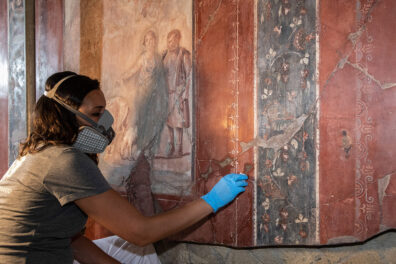
Getty Conservation Institute project specialist Tram Vo examines color photographs with a handheld loupe to identify the process used to create them.
Staff members of the Getty Conservation Institute (GCI) come from a great variety of disciplines. Chemists, architects, biologists, conservators, engineers, and other specialists lend their expertise to advance conservation of the world’s cultural heritage. Just as diverse as the staff’s backgrounds are the types of tools they use to aid the Conservation Institute’s conservation efforts.
“Take a picture, it’ll last longer!” is a well-known gibe, but Tram Vo, a project specialist at the Conservation Institute who specializes in the conservation of photographic materials, may not always agree. Photographs are susceptible to deterioration and damage if they are not properly cared for or stored. Before conservation treatment plans for photographic works can be created, however, “it’s important to identify the process that was used to create the photograph,” Tram explains. To do this, she uses a handheld loupe to get a closer look.
What Does the Tool Do?
Using the loupe, Tram can get a detailed look at photographs that, to the naked eye, may appear very similar. By looking at the photographs in magnified views, conservators can differentiate among various types of photographic processes. While some processes might produce prints with a dot or stripe pattern, others produce patterns in which the colors merge together.
Tram’s portable loupe stands about seven inches tall and provides a magnification power of 30x.
How Does It Advance Conservation Practice?
Knowing the process used to create the photograph allows conservators to choose the correct materials and procedures for its proper care and treatment. “Some materials and chemicals might be safe to use on one photographic process, but not on others,” Tram told me. “Using inappropriate materials and chemicals might cause irreversible damages.”
As the project manager of the Middle East Photograph Preservation Initiative (MEPPI), Tram trains those responsible for the care of photograph collections to use the magnifying loupe. While awareness of the importance of preserving photograph collections in the Middle East has grown in recent years, institutions in the region don’t always have the resources for scientific microscopes. Loupes provide an affordable way to identify photographs so that managers can decide long-term care and preservation plans for their collections.

A participant in a recent photographs conservation workshop in Budapest uses a hand loupe to study a historic photograph.
The loupe can also be used during treatment procedures such as in-painting, the process of retouching a small area of deterioration or loss of a photograph. “It’s hard to inpaint a photograph because there are no brushstrokes. There are just tiny little dots. So it’s helpful to look through a loupe while performing the procedure,” Tram explains.
This past summer, Tram trained conservators to use the loupe during a two-week workshop, Identification and Conservation Strategies for Color and Digital Prints, which took place at the Hungarian National Museum, Budapest, as part of the project’s Advanced Topics in Photographic Conservation series.
_______
Conservation Tools is an occasional series featuring tools essential to the work of the various specialists at the Getty Conservation Institute.




Hello, I was curious what brand of Loupe is Mrs. Tram Vo using? It looks like exactly what I need in my everyday research of collectibles. Thank You for Your Time. Anthony Galland
Could you kindly provide a link to or name the brand for the “… portable loupe (that) stands about seven inches tall and provides a magnification power of 30x.”? It’s difficult to find it online. Thank you.